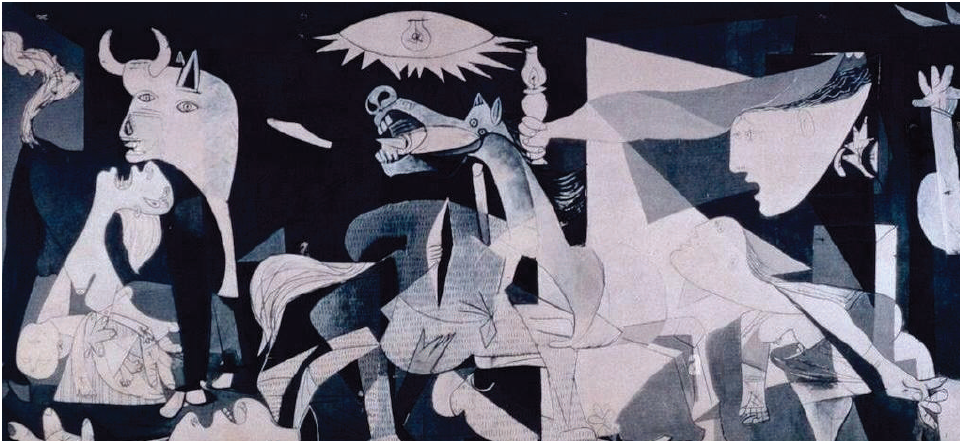This summer in Northampton has been the hottest since I arrived here and it reminds me of the scorching summers of Karachi when I used to wonder what winter would feel like. Yes, I do miss my home. I worry about my people. I did not realise one could have this non-stop over-worrying sensation until I witnessed the Pak-India four-day conflict which thankfully subsided but has not yet been fully resolved.
Indeed, the first casualty of war is truth. However, the next victim of a conflict is the artist, the writer, the thinker, and the men and women of science. The relationship between conflict and artists in, particular, is a complex one.
Throughout history, wars have influenced, impacted and inspired artists in numerous ways. Pablo Picasso expressed his protest over bombing of innocent civilians by painting ‘Guernica’’. Conflicts can inspire artists to create works that reflect their sentiments, perspectives and use their medium to critique tensions. It is also an undeniable reality that war and toxic nationalism can amplify ‘Us vs Them’ mentality in artists. Some artists and creatives reinforce this mindset through propaganda or nationalist art whereas others rise above it all. Other creatives challenge this Us vs Them notion by focusing on shared human experiences, bridging gaps by promoting empathy, and they even use their art form as an act of protest and resistance.
The conflict between Pakistan and India has significantly impacted artists and creatives from both countries. These recent tensions are a stark reminder that an artist and creative is the torch bearer of breaking the toxic stereotypes and should work for, and not against peace-making.
The Indian government imposed a ban on Pakistani artists, singers, and technicians working in the Indian film industry, affecting their careers and livelihood. Some Pakistani YouTube channels and TV channels like Hum TV were blocked in India which limited their viewers reach.
The release of movies featuring Pakistani stars such as Fawad Khan was postponed and the faces of Pakistani actors were removed from the posters of films released in the past years. In an act of retaliation, Pakistani cinema owners and distributors stopped screening Indian films and cancelled new Indian film releases until further notice.
Moreover, the conflict has disrupted cross-border artistic collaborations, affecting the cultural exchange and economic ties between the two nations. The ban on Pakistani content in India has created a digital divide, with some artists and channels advising their followers and fans to use VPNs to access their content. This conflict has fuelled nationalist sentiment with some artists and industry professionals advocating for a complete ban on cultural exchanges between the two countries. This unreasonable advocacy has its roots in the majoritarian nationalist sentiment which is more prevalent among the Indian creative industry professionals than in Pakistan.
Bollywood has a long history of scripting anti-Pakistan narrative. Immediately after its launch, 15 filmmakers and studios rushed to register the title ‘Operation Sindoor’. There have been some exceptions of course, where the artists condemn violence and promote peace. Many Pakistani artists, like Ali Gul Pir have vowed to ‘bridge gaps’ by saying ‘Let’s not make war, let’s just make art’ which is indeed the need of the hour. Indian actresses like Nandita Das who visits Pakistan to break barriers, Sunakshi Sinha speaking out against Indian media glorifying war, and writer Arundhati Roy saying it’s not the nations but the governments that are at war, are the voices that need to be heard and amplified.
And then there were many artists and creatives whose bias and prejudice knew no bounds. To name one such example, Javed Akhter, sparked outrage in Pakistan and India when he reportedly said that he would prefer to be in hell rather than go to Pakistan. Much criticism and many fitting rejoinders have been written, posted, and tweeted as a response to this unpalatable statement. It does make one wonder whether it is the ego, fear, or mere disinterestedness which resulted in this negative comment. Or is it the perpetual desire to remain in the spotlight when deep down you know your main claim to fame includes films like Sholay (copied from Once Upon a Time in the West and other films) and Zanjeer (borrowed from Clint Eastwood’s Dirty Harry)?
We can agree to disagree and let everyone have an opinion and their right to express that opinion. This reminds me of Otto Dix as a shining example. Dix, a German artist, was labelled a ‘degenerate’, had his anti-war paintings confiscated and he was forced to paint only landscapes by the Nazis. Otto Dix refused to shy away from the brutal realities of his experiences, even when it led to censorship and condemnation.
There have been instances from which we can learn and move forward. There are examples where countries have made efforts to protect cultural exchange and artistic collaborations despite conflicts. Regardless of the ideological divides during the cold war era, the United States and the then Soviet Union engaged in cultural exchanges by organising art exhibitions, musical and film performances, and literary events. American and Cuban artists collaborated on art projects with the help of third-party organisations. Even artists from Israel and Palestine have worked together on documentary films and art projects to promote peace and coexistence.
There are countless shining examples of when artists went out of their way to say no to war and pave the way for peace. Art transcends boundaries of all corporeal and non-corporeal forms. Only a bona fide artist demonstrates how to truly and fearlessly cross the traditional geopolitics, societal, stylistic, and cultural boundaries.
The writer is a filmmaker, translator, and media personnel based in the UK.



